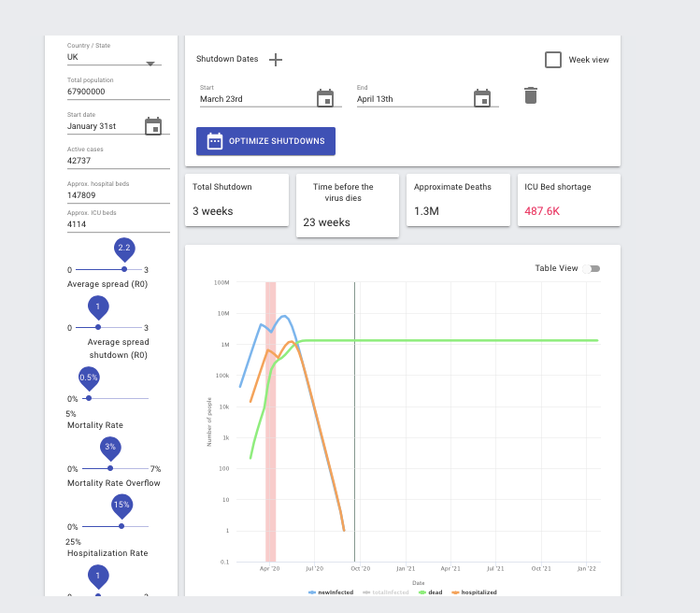According to this simulation, the UK will require two years of intermittent Covid-19 lockdown
According to this simulation, the UK will require two years of intermittent Covid-19 lockdown
April 9, 2020

by Max Smolaks 8 March 2020
We can either defeat the virus quickly or save lives, but not both
Policymakers all around the world are grappling with the questions around the Covid-19 pandemic. Are social distancing measures really necessary? How strict should the restrictions be, and how soon can they be lifted?
Multiple experts – including those at the University of Harvard and the Imperial College London – have suggested that the best way to defeat the virus is through intermittent lockdowns, relaxing restrictions on work and travel as the number of infections starts to fall, and bringing them back as the rate begins to climb again.

According to this simulation, the approach would be successful, but it would take a while: for example, in the case of the UK, it could take two years or longer for the virus to be defeated, with a total of 28 weeks of self-isolation required.
As always, we recommend treating such models as rough estimates to guide your thinking, rather than accurate predictions of the situation on the ground.
We’re in it for the long haul
The predictions are based on a publicly available model created by Ashish Shubham, a software engineer working for data analytics ‘unicorn’ ThoughtSpot.
The project is based on publicly available data and can approximate the effectiveness of intermittent lockdown in nearly 60 countries and all 50 of the American states.
“Currently, a lot of people are hoping that we will be able to end social distancing in a few weeks and get back to normal. The model shows that could not be farther from the truth,” Amit Prakash, CTO of the company, wrote in a blog.

The model suggests that if the UK government lifted current restrictions on 13 April – the date of the upcoming government policy review – the virus could be defeated by September, in just 23 weeks.
However the potential death toll would near 1.3 million and the sheer amount of cases would cause a shortage of hundreds of thousands of intensive care unit beds, completely overwhelming the healthcare system.
According to the model, an approach that switches between restricted and free movement would reduce the overall number of deaths to ~200k and the shortage of ICU beds at the peak of the infection to ~50k.
The model invites several interesting ideas, introducing variables in the spread of the virus during lockdown – which depends on factors like the willingness of citizens to follow government advice – and the increase in Covid-19 mortality rates that would result from a healthcare system stretched over capacity.
“A number of us have read the articles about social distancing and flattening the curve, but very few people understand how our choices can make a difference to the spread in precise terms,” Prakash said.
“That’s why we built a mathematical model for understanding various scenarios that may occur for different durations of shelter-in-place. It includes an algorithm we created that computes an optimal schedule for shutdown based on two different strategies to either contain or mitigate the impact of Covid-19.”
The team at ThoughtSpot analyzed the benefits and drawbacks of four potential containment scenarios, and came to the conclusion that multiple, short shutdowns were the most humane way to reach 'herd immunity' that would essentially disarm the virus, and the most likely scenario to unfold based on current policy.
Of course, these are mathematicians and data specialists, rather than healthcare professionals, and this scenario assumes no major medical breakthrough is reached within the next 18 months.
If you’re in the mood for more simulations, here’s the destructive power of a sneeze, portrayed using computational fluid dynamics:
About the Author(s)
You May Also Like
.jpg?width=700&auto=webp&quality=80&disable=upscale)
.jpg?width=700&auto=webp&quality=80&disable=upscale)
.jpg?width=700&auto=webp&quality=80&disable=upscale)
.jpg?width=300&auto=webp&quality=80&disable=upscale)
.jpg?width=300&auto=webp&quality=80&disable=upscale)
.jpg?width=300&auto=webp&quality=80&disable=upscale)
.jpg?width=300&auto=webp&quality=80&disable=upscale)
.jpg?width=300&auto=webp&quality=80&disable=upscale)